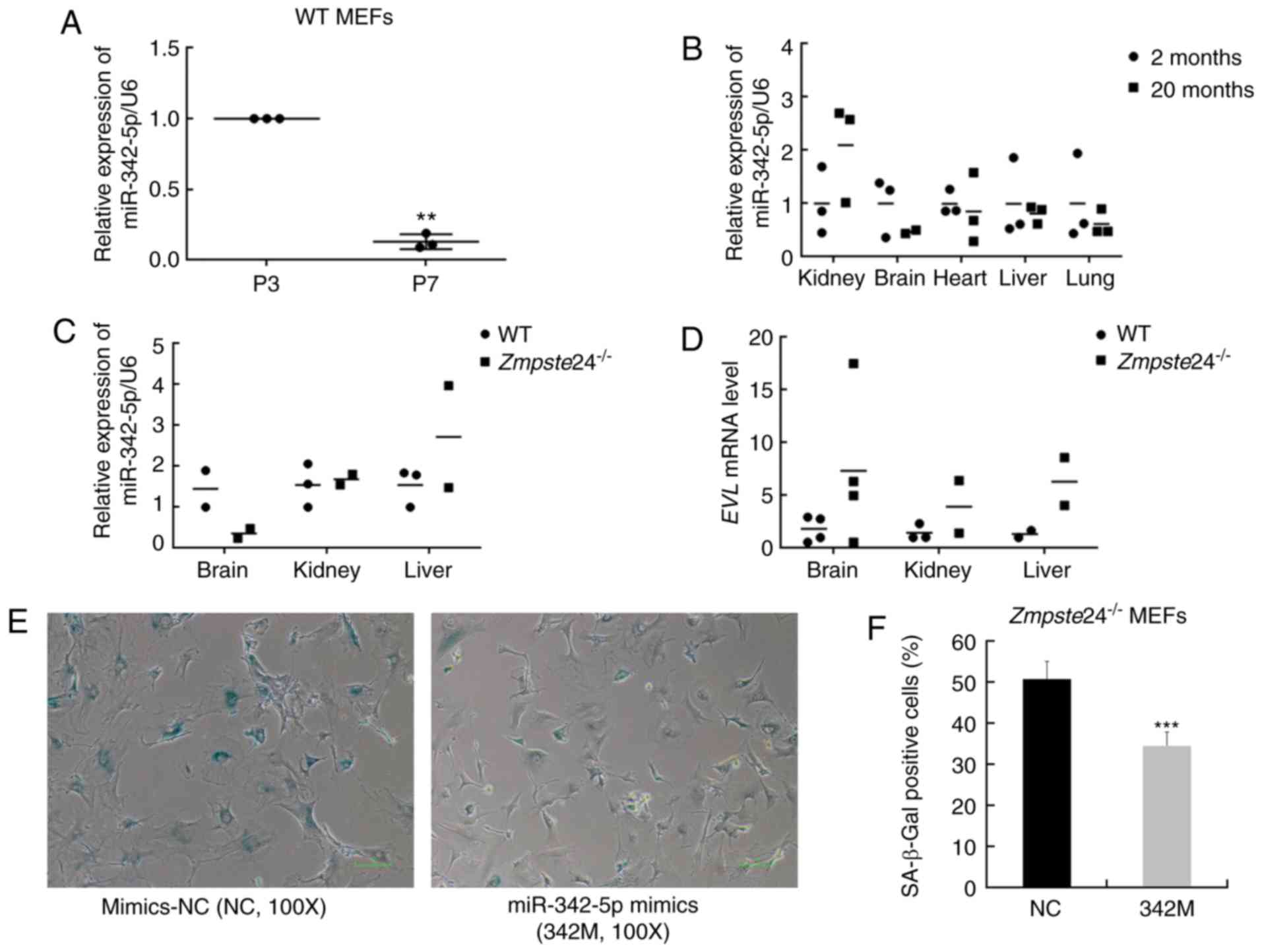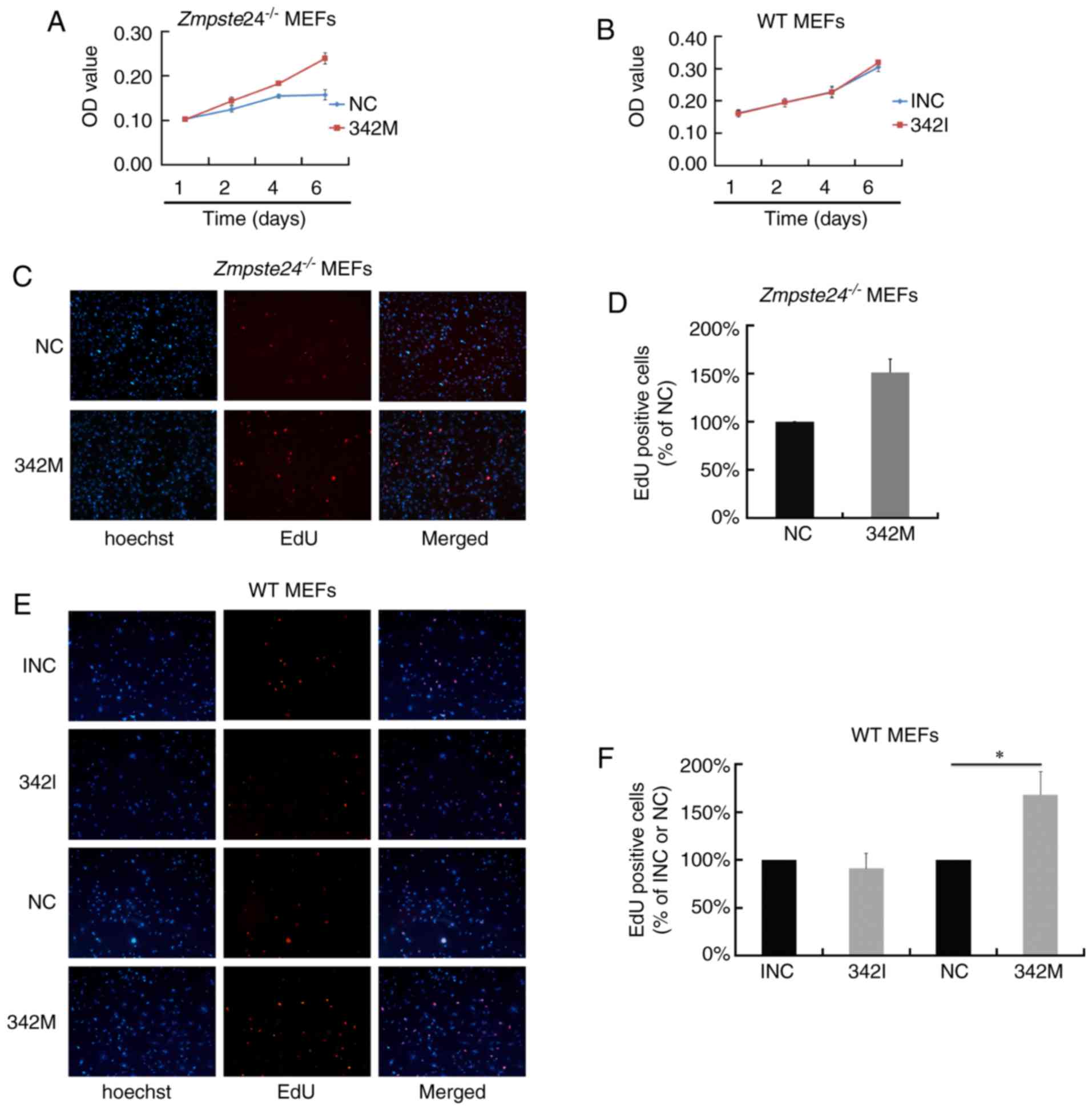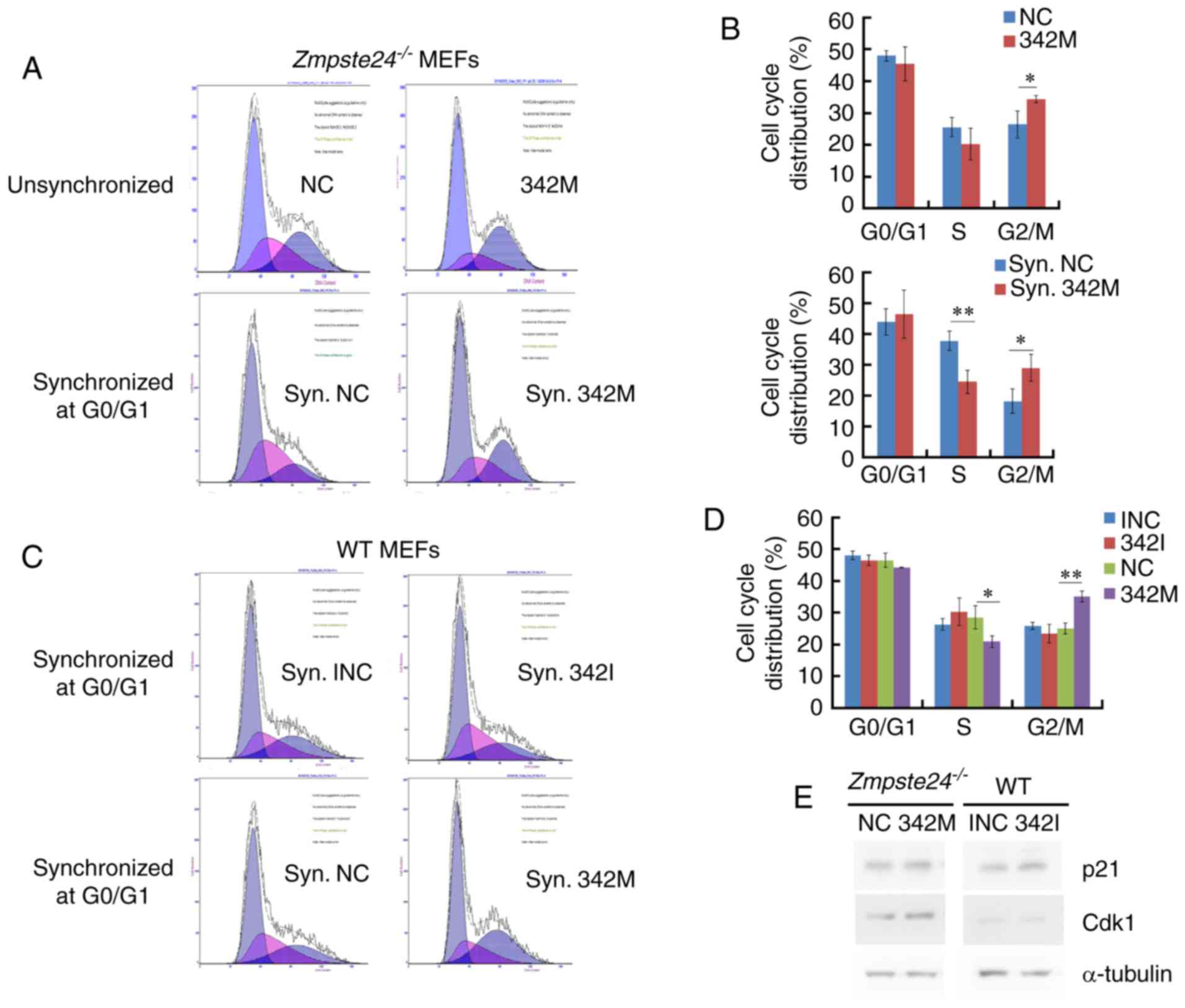|
1
|
McCulloch K, Litherland GJ and Rai TS:
Cellular senescence in osteoarthritis pathology. Aging Cell.
16:210–218. 2017. View Article : Google Scholar : PubMed/NCBI
|
|
2
|
Khan SY, Awad EM, Oszwald A, Mayr M, Yin
X, Waltenberger B, Stuppner H, Lipovac M, Uhrin P and Breuss JM:
Premature senescence of endothelial cells upon chronic exposure to
TNFα can be prevented by N-acetyl cysteine and plumericin. Sci Rep.
7:395012017. View Article : Google Scholar : PubMed/NCBI
|
|
3
|
Liu B, Wang J, Chan KM, Tjia WM, Deng W,
Guan X, Huang JD, Li KM, Chau PY, Chen DJ, et al: Genomic
instability in laminopathy-based premature aging. Nat Med.
11:780–785. 2005. View
Article : Google Scholar : PubMed/NCBI
|
|
4
|
Eriksson M, Brown WT, Gordon LB, Glynn MW,
Singer J, Scott L, Erdos MR, Robbins CM, Moses TY, Berglund P, et
al: Recurrent de novo point mutations in laminA cause
Hutchinson-Gilford progeria syndrome. Nature. 423:293–298. 2003.
View Article : Google Scholar : PubMed/NCBI
|
|
5
|
Pendás AM, Zhou Z, Cadiñanos J, Freije JM,
Wang J, Hultenby K, Astudillo A, Wernerson A, Rodríguez F,
Tryggvason K and López-Otín C: Defective prelamin A processing and
muscular and adipocyte alterations in Zmpste24
metalloproteinase-deficient mice. Nat Genet. 31:94–99.
2002.PubMed/NCBI
|
|
6
|
Goldman RD, Shumaker DK, Erdos MR,
Eriksson M, Goldman AE, Gordon LB, Gruenbaum Y, Khuon S, Mendez M,
Varga R and Collins FS: Accumulation of mutant lamin A causes
progressive changes in nuclear architecture in Hutchinson-Gilford
progeria syndrome. Proc Natl Acad Sci USA. 101:pp. 8963–8968. 2004;
View Article : Google Scholar : PubMed/NCBI
|
|
7
|
Barthélémy F, Navarro C, Fayek R, Da Silva
N, Roll P, Sigaudy S, Oshima J, Bonne G, Papadopoulou-Legbelou K,
Evangeliou AE, et al: Truncated prelaminA expression in HGPS-like
patients: A transcriptional study. Eur J Hum Genet. 23:1051–1061.
2015. View Article : Google Scholar : PubMed/NCBI
|
|
8
|
Olive M, Harten I, Mitchell R, Beers JK,
Djabali K, Cao K, Erdos MR, Blair C, Funke B, Smoot L, et al:
Cardiovascular pathology in Hutchinson-Gilford progeria:
Correlation with the vascular pathology of aging. Arterioscler
Thromb Vascr Biol. 30:2301–2309. 2010. View Article : Google Scholar
|
|
9
|
Scaffidi P and Misteli T: Lamin
A-dependent nuclear defects in human aging. Science. 312:1059–1063.
2006. View Article : Google Scholar : PubMed/NCBI
|
|
10
|
Cao K, Blair CD, Faddah DA, Kieckhaefer
JE, Olive M, Erdos MR, Nabel EG and Collins FS: Progerin and
telomere dysfunction collaborate to trigger cellular senescence in
normal human fibroblasts. J Clin Invest. 121:2833–2844. 2011.
View Article : Google Scholar : PubMed/NCBI
|
|
11
|
Arancio W, Pizzolanti G, Genovese SI,
Pitrone M and Giordano C: Epigenetic involvement in
Hutchinson-Gilford progeria syndrome: A mini-review. Gerontology.
60:197–203. 2014. View Article : Google Scholar : PubMed/NCBI
|
|
12
|
Jung HJ, Coffinier C, Choe Y, Beigneux AP,
Davies BS, Yang SH, Barnes RH II, Hong J, Sun T, Pleasure SJ, et
al: Regulation of prelamin A but not lamin C by miR-9, a
brain-specific microRNA. Proc Natl Acad Sci USA. 109:pp. E423–E431.
2012; View Article : Google Scholar : PubMed/NCBI
|
|
13
|
Nissan X, Blondel S, Navarro C, Maury Y,
Denis C, Girard M, Martinat C, De Sandre-Giovannoli A, Levy N and
Peschanski M: Unique preservation of neural cells in
Hutchinson-Gilford progeria syndrome is due to the expression of
the neural-specific miR-9 microRNA. Cell Rep. 2:1–9. 2012.
View Article : Google Scholar : PubMed/NCBI
|
|
14
|
Ugalde AP, Ramsay AJ, de la Rosa J, Varela
I, Mariño G, Cadiñanos J, Lu J, Freije JM and López-Otín C: Aging
and chronic DNA damage response activate a regulatory pathway
involving miR-29 and p53. EMBO J. 30:2219–2232. 2011. View Article : Google Scholar : PubMed/NCBI
|
|
15
|
Xiong XD, Jung HJ, Gombar S, Park JY,
Zhang CL, Zheng H, Ruan J, Li JB, Kaeberlein M, Kennedy BK, et al:
MicroRNA transcriptome analysis identifies miR-365 as a novel
negative regulator of cell proliferation in Zmpste24-deficient
mouse embryonic fibroblasts. Mutat Res. 777:69–78. 2015. View Article : Google Scholar : PubMed/NCBI
|
|
16
|
Bear JE, Svitkina TM, Krause M, Schafer
DA, Loureiro JJ, Strasser GA, Maly IV, Chaga OY, Cooper JA, Borisy
GG and Gertler FB: Antagonism between Ena/VASP proteins and actin
filament capping regulates fibroblast motility. Cell. 109:509–521.
2002. View Article : Google Scholar : PubMed/NCBI
|
|
17
|
Tavares S, Vieira AF, Taubenberger AV,
Araújo M, Martins NP, Brás-Pereira C, Polónia A, Herbig M, Barreto
C, Otto O, et al: Actin stress fiber organization promotes cell
stiffening and proliferation of pre-invasive breast cancer cells.
Nat Commun. 8:152372017. View Article : Google Scholar : PubMed/NCBI
|
|
18
|
Sun X, Wu Y, Gu M and Zhang Y: miR-342-5p
decreases ankyrin G levels in Alzheimer's disease transgenic mouse
models. Cell Rep. 6:264–270. 2014. View Article : Google Scholar : PubMed/NCBI
|
|
19
|
Wei Y, Nazari-Jahantigh M, Chan L, Zhu M,
Heyll K, Corbalán-Campos J, Hartmann P, Thiemann A, Weber C and
Schober A: The microRNA-342-5p fosters inflammatory macrophage
activation through an Akt1- and microRNA-155-dependent pathway
during atherosclerosis. Circulation. 127:1609–1619. 2013.
View Article : Google Scholar : PubMed/NCBI
|
|
20
|
Gao F, Zhang YF, Zhang ZP, Fu LA, Cao XL,
Zhang YZ, Guo CJ, Yan XC, Yang QC, Hu YY, et al: miR-342-5p
regulates neural stem cell proliferation and differentiation
downstream to Notch signaling in mice. Stem Cell Reports.
8:1032–1045. 2017. View Article : Google Scholar : PubMed/NCBI
|
|
21
|
Wang J, Zhang Y, Xu S, Li W, Chen Z, Wang
Z, Han X, Zhao Y and Li S: Prognostic significance of G2/M arrest
signaling pathway proteins in advanced non-small cell lung cancer
patients. Oncol Lett. 9:1266–1272. 2015.PubMed/NCBI
|
|
22
|
Fesquet D, Labbé JC, Derancourt J, Capony
JP, Galas S, Girard F, Lorca T, Shuttleworth J, Dorée M and
Cavadore JC: The MO15 gene encodes the catalytic subunit of a
protein kinase that activates cdc2 and other cyclin-dependent
kinases (CDKs) through phosphorylation of Thr161 and its
homologues. EMBO J. 12:3111–3121. 1993.PubMed/NCBI
|
|
23
|
Su H, Yang JR, Xu T, Huang J, Xu L, Yuan Y
and Zhuang SM: MicroRNA-101, down-regulated in hepatocellular
carcinoma, promotes apoptosis and suppresses tumorigenicity. Cancer
Res. 69:1135–1142. 2009. View Article : Google Scholar : PubMed/NCBI
|
|
24
|
Livak KJ and Schmittgen TD: Analysis of
relative gene expression data using real-time quantitative PCR and
the 2(-Delta DeltaC(T)) Method. Methods. 25:402–408. 2001.
View Article : Google Scholar : PubMed/NCBI
|
|
25
|
Niculescu AB III, Chen X, Smeets M, Hengst
L, Prives C and Reed SI: Effects of p21(Cip1/Waf1) at both the G1/S
and the G2/M cell cycle transitions: pRb is a critical determinant
in blocking DNA replication and in preventing endoreduplication.
Mol Cell Biol. 18:629–643. 1998. View Article : Google Scholar : PubMed/NCBI
|
|
26
|
Barboule N, Lafon C, Chadebech P, Vidal S
and Valette A: Involvement of p21 in the PKC-induced regulation of
the G2/M cell cycle transition. FEBS Lett. 444:32–37. 1999.
View Article : Google Scholar : PubMed/NCBI
|
|
27
|
Grady WM, Parkin RK, Mitchell PS, Lee JH,
Kim YH, Tsuchiya KD, Washington MK, Paraskeva C, Willson JK, Kaz
AM, et al: Epigenetic silencing of the intronic microRNA
hsa-miR-342 and its host gene EVL in colorectal cancer. Oncogene.
27:3880–3888. 2008. View Article : Google Scholar : PubMed/NCBI
|
|
28
|
Van der Auwera I, Yu W, Suo L, Van Neste
L, van Dam P, Van Marck EA, Pauwels P, Vermeulen PB, Dirix LY and
Van Laere SJ: Array-based DNA methylation profiling for breast
cancer subtype discrimination. PLoS One. 5:e126162010. View Article : Google Scholar : PubMed/NCBI
|
|
29
|
Yan XC, Cao J, Liang L, Wang L, Gao F,
Yang ZY, Duan JL, Chang TF, Deng SM, Liu Y, et al: miR-342-5p is a
Notch downstream molecule and regulates multiple angiogenic
pathways including Notch, vascular endothelial growth factor and
transforming growth factor β signaling. J Am Heart Assoc.
5:e0030422016. View Article : Google Scholar : PubMed/NCBI
|
|
30
|
Calin GA and Croce CM: MicroRNA signatures
in human cancers. Nat Rev Cancer. 6:857–866. 2006. View Article : Google Scholar : PubMed/NCBI
|
|
31
|
Esquela-Kerscher A and Slack FJ: Oncomirs
- microRNAs with a role in cancer. Nat Rev Cancer. 6:259–269. 2006.
View Article : Google Scholar : PubMed/NCBI
|
|
32
|
Peter M, Le Peuch C, Labbé JC, Meyer AN,
Donoghue DJ and Doree M: Initial activation of cyclin-B1-cdc2
kinase requires phosphorylation of cyclin B1. EMBO Rep. 3:551–556.
2002. View Article : Google Scholar : PubMed/NCBI
|
|
33
|
Santamaría D, Barrière C, Cerqueira A,
Hunt S, Tardy C, Newton K, Cáceres JF, Dubus P, Malumbres M and
Barbacid M: Cdk1 is sufficient to drive the mammalian cell cycle.
Nature. 448:811–815. 2007. View Article : Google Scholar : PubMed/NCBI
|
|
34
|
Schneider C, King RM and Philipson L:
Genes specifically expressed at growth arrest of mammalian cells.
Cell. 54:787–793. 1988. View Article : Google Scholar : PubMed/NCBI
|
|
35
|
Zhang T, Dayanandan B, Rouiller I,
Lawrence EJ and Mandato CA: Growth-arrest-specific protein 2
inhibits cell division in Xenopus embryos. PLoS One. 6:e246982011.
View Article : Google Scholar : PubMed/NCBI
|
|
36
|
Kondo Y, Shen L, Cheng AS, Ahmed S,
Boumber Y, Charo C, Yamochi T, Urano T, Furukawa K, Kwabi-Addo B,
et al: Gene silencing in cancer by histone H3 lysine 27
trimethylation independent of promoter DNA methylation. Nat Genet.
40:741–750. 2008. View
Article : Google Scholar : PubMed/NCBI
|
|
37
|
Petroulakis E, Parsyan A, Dowling RJ,
LeBacquer O, Martineau Y, Bidinosti M, Larsson O, Alain T, Rong L,
Mamane Y, et al: p53-dependent translational control of senescence
and transformation via 4E-BPs. Cancer Cell. 16:439–446. 2009.
View Article : Google Scholar : PubMed/NCBI
|













